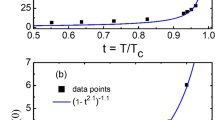Large and randomly arranged pinning centers cause a strong deformation of a flux line lattice, so that each pinning center acts on the lattice with a maximum force. The average force for such single-particle pinning can be inferred from a simple summing procedure and has a domelike dependence on magnetic field. Pinning centers of average force, such as clusters of dislocations, strongly deform the flux line lattice only in weak fields and in fields close to the critical field, where there is a peak in the dependence of the critical current on magnetic field. In the range of intermediate fields there is a weak collective pinning. A large concentration of weak centers leads to collective pinning in all fields. In this case, near the critical field a critical current peak should be observed. To explain this peak and to define the boundaries between the regions of collective and single-particle pinning the possible break-off of the flux line lattice from the lines of magnetic force should be taken into consideration, which leads to extra softening of the lattice.
Similar content being viewed by others
References
A. A. Abrikosov, Zh. Eksp. Teor. Fiz. 32, 1442 (1957).
P. W. Anderson, Phys. Rev. Lett. 9, 309 (1962).
M. A. R. Le Blanc and W. A. Little, in Proc. 7th Inter. Conf. on Low Temp. Phys. (University of Toronto Press, 1961), p. 362; T. G. Berlincourt, R. R. Hake, and D. H. Leslie, Phys. Rev. Lett. 6, 671 (1971).
M. Steingart, A. G. Purz, and E. J. Kramer, J. Appl. Phys. 44, 5580 (1973).
S. Borka, I. I. Goncharov, D. Frichevski, and I. S. Khukhareva, Fiz. Nizkikh Temp. 3, 716 (1977).
L. Ya. Vinnikov, V. I. Grigor'ev and O. V. Zharikov, Zh. Eksp. Teor. Fiz. 71, 252 (1976).
A. I. Larkin, Zh. Eksp. Teor. Fiz. 58, 1466 (1970).
A. I. Larkin and Yu. N. Ovchinnikov, Zh. Eksp. Teor. Fiz. 65, 1704 (1973).
E. H. Brandt, J. Low Temp. Phys. 26, 709 (1977).
A. I. Larkin and Yu. N. Ovchinnikov, Pisma Zh. Eksp. Teor. Fiz. 27, 301 (1978).
R. Labusch, Cryst. Lattice Defects 1, 1 (1969).
G. Eilenberger, Z. Phys. 214, 195 (1968).
A. I. Larkin and Yu. N. Ovchinnikov, Zh. Eksp. Teor. Fiz. 55, 2262 (1968).
Yu. N. Ovchinnikov, Zh. Eksp. Teor. Fiz. 66, 1100 (1974).
R. Schmucher and E. H. Brandt, Phys. Stat. Sol. (b) 79, 479 (1977).
A. M. Campbell and J. E. Evetts, Critical Currents in Superconductors (London, 1972).
K. E. Osborne and E. J. Kramer, Phil. Mag. 29, 685 (1974).
A. I. Larkin and Yu. N. Ovchinnikov, Zh. Eksp. Teor. Fiz. 61, 1221 (1971).
S. Borka, I. N. Goncharov, D. Frichevski, and I. S. Khukhareva, Fiz. Nizkikh Temp. 3, 598 (1977).
E. J. Kramer, MSC Report-2857; J. Appl. Phys. 49, 742 (1978).
A. A. Moshenskii, N. Ya. Fogel', A. S. Sidorenko, A. M. Gluchov, I. M. Dmitrienko, L. P. Tishchenko, and Ya. M. Fogel', Fiz. Nizkikh Temp. 2, 685 (1976).
Author information
Authors and Affiliations
Rights and permissions
About this article
Cite this article
Larkin, A.I., Ovchinnikov, Y.N. Pinning in type II superconductors. J Low Temp Phys 34, 409–428 (1979). https://doi.org/10.1007/BF00117160
Received:
Issue Date:
DOI: https://doi.org/10.1007/BF00117160




